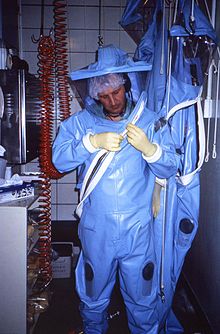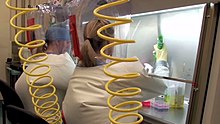Positive pressure personnel suit

Positive pressure personnel suits (PPPS)—or positive pressure protective suits, informally known as "space suits", "moon suits", "blue suits", etc.—are highly specialized, totally encapsulating, industrial protection garments worn only within special
The PPPS is a sophisticated variety of
Operation
This section needs expansion. You can help by adding to it. (December 2011) |

Fresh, filtered air is typically supplied to the interior of a PPPS via overhead tubing. In addition to the physical barrier provided, the positive pressurization offers additional protection in the event of exposure through a defect or puncture in the suit, for if the suit's integrity is compromised, air will be forced out instead of being sucked in. Extensive training with the PPPS is required to safely pursue research in a PPPS within a biosafety facility.
In 1987, USAMRIID scientist Joel Dalrymple described the subjective experience of working in a PPPS and "his solemn respect for working in the hot suits" to a journalist:
"I don't want anyone to prep my suit," he says. "It is like packing your own parachute." Indeed, it is no picnic to do experiments weighted down with all that gear and paraphernalia. The air hisses so loudly you have to crimp the air supply to talk to your lab partner. The plastic eyeshield reflects the lightbulbs in the ceiling. Heat builds up. Fatigue sets in. You can't scratch or go to the bathroom. And all the time, there is the danger that you will slip and puncture your suit and infect yourself. After working in the hot suit, everyone showers and checks the suit, just to make sure that no tiny punctures turn up. "It's just instinct," says Dalrymple. "You come out, pull off your glove, blow it up and hold it. You've been working with needles all day. It is refreshing to see a glove that remains inflated."[2]
History
This section needs expansion. You can help by adding to it. (December 2011) |
In the late 1970s,
Examples
- The U.S. Army's Demilitarization Protective Ensemble
- The ILC Dover Chemturion "Blue Suit"
- The Delta Protection "Orange Suit"
- The
-
ABSL-4laboratorian working in an ILC Dover Chemturion "Blue Suit".
-
CDC microbiologists in Delta Protection "Orange Suits"
-
Laboratorians working in Sperian Protection "White Suit" atNIAIDBSL-4 lab
-
Maintenance workers inNewport Chemical Agent Disposal Facility.
In fiction and film
PPPSs — along with many less elaborate types of hazmat suit — have long been a staple of the
In the Mass Effect series of video games, several types of aliens use variants of PPPSs, most notably the character Tali, who has a compromised immune system. In Moebius's comic Edena, the residents of the Nest City wear similar suits at all times to protect themselves from diseases, as do the denizens of Javecek in Carla Speed McNeill's comic Finder.[13][14] In Bethesda's Fallout games, the Hazmat Suit is an armor item which can be equipped on a character to prevent radiation damage. In Capcom's Resident Evil, at the very beginning of the "Mansion Incident", those inside Spencer Mansion were told to don PPPS after a viral outbreak within the facility.[15]
See also
- Racal suit — a positive pressure suit with a battery-operated blower for expeditionary use.
- Demilitarization Protective Ensemble (DPE) — a heat-sealed, one-time-use positive pressure personnel suit.
- Pressure suit — the pressurized garment worn by high-altitude pilots and astronauts.
- Hazmat suit — unpressurized protective garment.
- Fire proximity suit — a suit designed to protect from extremely high temperatures.
- Powered air-purifying respirator — the positive-pressure mask or hood.
References
- ^ Seligson, Susan (7 March 2013). "Video Offers Glimpse of Biosafety Level 4 Lab Science webcast "threads the NEIDL"". BU Today. Retrieved 5 December 2014.
- ^ McDermott, Jeanne (1987), The Killing Winds: The Menace of Biological Warfare; New York; Arbor House, pp 220-221.
- ^ Masibay, Kimberly (27 May 2003). "A Chic French Import Attracts U.S. Attention". Popular Science. Retrieved 5 December 2014.
- ^ "84 -- BSL-4 Protective Suit: Solicitation Number: Reference-Number-00HCVHDB-2007-45398". CDC. Retrieved 5 December 2014.
- ^ "PHIL # 10727". CDC. Retrieved 5 December 2014.
- ^ "PHIL # 10724". CDC. Retrieved 5 December 2014.
- ^ "Stanley Personal Protection History". Stanley. Archived from the original on 2014-12-09. Retrieved 5 December 2014.
- ^ "Solutions to Protect People Against Particles" (PDF). NanoSafe. 2008. Archived from the original (PDF) on 23 May 2013. Retrieved 5 December 2014.
- ^ "Sperian Protection, Historical Player". Sperian Protection. Archived from the original on 11 February 2011. Retrieved 5 December 2014.
- ^ "Product Family BSL 4". Honeywell. Retrieved 5 December 2014.
- ^ U.S. Army Chemical Materials Agency, Suiting up for Safety, Fact Sheet Archived 2015-09-23 at the Wayback Machine. Retrieved on 2011-02-11.
- ^ Sperian Protection is now part of Honeywell; Sperian Group History
- ^ Giraud, Jean. Edena.
- ^ McNeill, Carla. Finder: Third World.
- ISBN 9784757709805.




